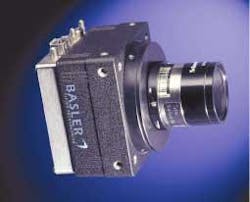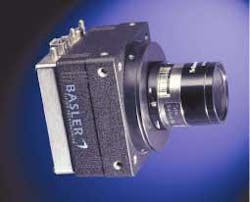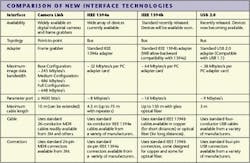IEEE 1394-based cameras promote digital imaging
About two years ago, the makers of industrial-grade digital cameras almost universally relied on proprietary RS-644-based camera interfaces. These interfaces often made systems integration difficult, and many designers and users were demanding something better. A new bus standard, IEEE 1394 (FireWire), and an upcoming standard, USB (Universal Serial Bus) 2, were hot topics at the time, and they seemed to offer an easier-to-use camera interface (see table on p. S4). Although a few industrial-grade cameras with an IEEE 1394 interface were becoming available, many industry analysts were predicting they would not meet market needs.
But then, a series of events changed the market landscape. IEEE 1394-based devices such as digital camcorders began to catch on in the consumer market. These products generated a wave of sales, which, in turn, raised the general awareness of the IEEE 1394 bus and emphasized its usefulness in transmitting real-time video.
In July 2000, the 1394 Trade Association (Grapevine, TX) issued a new version of its specification for the operation of 1394-based digital industrial cameras. This specification is commonly referred to as DCAM (Digital Camera). It defines a characteristic set of features for industrial-grade digital cameras (as opposed to consumer cameras, which don't follow DCAM and use image-compression formats). DCAM also outlines how the 1394 bus is to be used to transmit video, data, and camera control signals. The new version of the DCAM specification was an improvement over past releases, and it encouraged camera manufacturers to reconsider the use of IEEE 1394.
About this time, a major European manufacturer initiated a competitive development contract for DCAM- compliant industrial-grade IEEE 1394 cameras. The manufacturers who participated in this competition became convinced that IEEE 1394-based cameras offered significant advantages to their customers and that a sizable market existed for these cameras. They also realized that IEEE 1394-based cameras could offer the same exposure-control methods, triggering capabilities, frame rates, and high image quality that industrial users have traditionally demanded from their cameras (see photo).
For example, the 32-Mbyte/s real-time video-carrying capacity of the IEEE 1394 bus compared favorably with the 20- to 40-Mbyte/s capacity typically offered by RS-644 camera interfaces. And the ability to carry video, data, camera-control signals, and power over six wires in a standardized cable with IEEE 1394 rather than the 24 or more wires in the proprietary cables used with RS-644 was readily accepted as an exceptional advantage.
Several camera manufacturers now supply IEEE 1394 products, and these industrial-grade cameras have made noteworthy inroads into the market. Meanwhile, the 1394 Trade Association continues to be active in improving and expanding the DCAM specification.
Camera groups
Today's IEEE 1394 camera users appear to fall into three groups. The first group includes makers of stand-alone systems such as microscopy and ophthalmic equipment. Users of these systems perform sophisticated image analysis both manually and with software. They want a quick and simple way to get to the point of acquiring images, and they are not overly concerned with the mechanics of image acquisition. The plug-and-play nature of the 1394 camera/cable/interface board/driver package offered by some camera manufacturers is ideal for these users. Such a system is cost-effective and meets the condition of fast ramp-up.
The second group includes makers of traditional image-analysis packages, such as Matrox Imaging (Dorval, QC, Canada) and National Instruments (Austin, TX). For these users, the simplified cabling and hardware, the self-identification nature of 1394-based cameras as no camera configuration file is needed, and the general availability of drivers designed to operate DCAM-compliant cameras are great benefits.
In addition, because the camera interface is standardized, it makes the task of testing cameras from different manufacturers easier. This gives system designers greater opportunities to test competing cameras and to select the one that is most appropriate for their system. Simplified testing and integration often lead to shorter product-design time, a major advantage in the machine-vision and image-processing market.
System manufacturers in this second group achieve substantial cost savings. Easier testing and system integration result in lower system-design costs. Since IEEE 1394 cables are standardized and widely available, they tend to be less expensive. And for systems that include multiple cameras, IEEE 1394 accommodates multiple cameras on a single bus with a single interface board for more cost savings. For example, three CCIR (720 × 480-pixel) resolution digital cameras operating at an 8-bit depth and 20 frames/s generate about 27 Mbytes/s of image data. This bandwidth is below the 32-Mbyte/s video-data-carrying capacity of an IEEE 1394 bus, so the three cameras could be plugged into a single, multiport interface board. In the past, the use of three cameras typically required three LVDS (low-voltage differential-signaling) digital boards.
The third group of 1394 camera users includes those who design complete systems with their own image-analysis package and, sometimes, with their own frame grabber. For these systems, the availability of drivers designed for DCAM-compliant IEEE 1394 cameras is a major advantage. These drivers allow programmers easy access to all of the standard functions available on DCAM-compliant cameras. New drivers also allow access to "special" camera features, that is, proprietary camera features that are manufacturer-specific but adhere to some general guidelines in the DCAM specification. These drivers typically include high-level application programming interfaces that enable programmers to easily write code that can operate the camera from within the system's control or image-analysis software.
Users of this third group of cameras, of course, benefit from the cost savings represented by easier system integration and testing when using 1394 cameras. In this case, they also obtain savings by using a simple IEEE 1394 interface card along with its self-written analysis software, rather than using an expensive, commercially available frame-grabber/image-analysis software package.
What lies ahead?
Several industrial equipment manufacturers are working on the development of "automation systems." These systems include a bus—typically IEEE 1394—into which a variety of devices can be plugged, such as cameras, motion controllers, sensors, and servos. They are also expected to include a package of configurable control and analysis software. Their goal is to design a flexible system that can easily be configured to work in different industrial applications. An extreme example of this concept is the International Space Station. It contains a 1394 bus, and a variety of 1394 peripheral devices can be added to or removed from the bus as needed. Assuming that these automation systems are successfully developed and sold, they represent a new market for IEEE 1394 cameras.
Users of RS-170 analog cameras may finally go digital. In the past, these users have resisted using a digital camera system because digital systems typically cost up to five times more than analog systems. The low cost of IEEE 1394 cables and interface boards, coupled with the fact that manufacturers are actively developing low-cost IEEE 1394 cameras, will put digital systems within reach of analog users. Industry analysts project that analog users will be able to go digital, today, for approximately 1.5 times their current analog costs or less.
Because digital cameras eliminate problems commonly encountered with RS-170 cameras, such as pixel jitter and interlace blurring, this slight increase in cost now becomes justifiable. Also, the sensors used in newer digital cameras can integrate more features directly onto the sensor chip. This integration decreases the camera's overall complexity and allows camera manufacturers to offer feature-rich digital cameras that can compete with RS-170 cameras on price. As the business climate becomes more competitive, users of systems with RS-170 cameras are becoming more demanding about the performance of the systems they buy. One way that manufacturers of analog camera-based systems can meet these demands is by switching to digital cameras. Because analog types presently capture the largest segment of the camera market, the opportunity for greater penetration into that market is a major goal of digital camera manufacturers.
The introduction of IEEE 1394b devices is anticipated in the near future. The recently released IEEE 1394b standard doubles the bandwidth available on the bus to 800 Mbits/s and provides for up to 1600 Mbits/s in the future. It also greatly increases the maximum cable length between devices. For example, it allows the use of glass optical-fiber cables along with the Molex Inc. (Lisle, IL) LC connector system to achieve cable lengths of up to 100 meters.
A major selling point of IEEE 1394 is that multiple cameras can easily be connected to a single bus. The increased 1394b bandwidth expands this capability. Moreover, industrial users always demand longer cables, and 1394b also addresses that issue. The advantages of IEEE 1394b are expected to make cameras based on this standard even more attractive to system designers.
ANTHONY PIERI is technical and marketing communications specialist at Basler Vision Technologies, Exton, PA.
Basler Vision Technologies
Exton, PA
www.basler-vc.com
Matrox Imaging
Dorval, QC, Canada
www.matrox.com
Molex Inc.
Lisle, IL
www.molex.com
National Instruments
Austin, TX
www.ni.com
1394 Trade Association
Grapevine, TX
www.1394ta.org
3M
St. Paul, MN
www.3m.com


